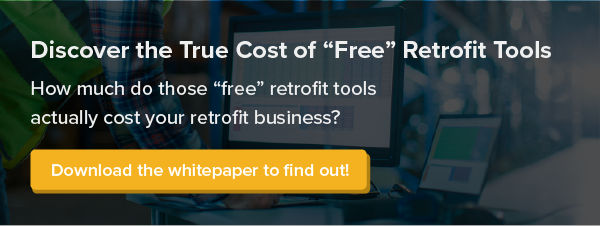
The energy industry is changing at… well, light-speed. As both regulations and demand shift toward greater sustainability, and as new technologies and applications rise to meet those demands, it’s hard to keep up with it all.
And if you’re a busy energy contractor growing your business, where will you find the time to figure out which trends and advancements are worth investing in … and which are just passing fads?
That’s why we spoke to Timothy Unruh, the Executive Director of The National Association of Energy Companies (NAESCO), who gave us his thoughts on where the industry is going.
Q. We’re hearing a lot about Energy as a Service, or EaaS. What can you tell us about it?
The concept of Energy as a Service first emerged in the early 2010s with the now familiar lighting as a service. It has since expanded to include various energy solutions like solar as a service, battery storage as a service, and energy management as a service.
EaaS has gained significant attention in recent years, thanks to technological advancements, the rising demand for energy efficiency and renewable solutions, and its unique business model that allows customers to access energy services without the need for any initial capital investment.
Typically structured as a subscription, EaaS involves the use of electrical devices owned by a service company or the management of energy consumption to fulfill the specific energy requirements of the customers.
From an ESCO viewpoint, EaaS is focused on providing a turnkey solution that covers facility management, equipment, services, and maintenance and repair for a client. It may or may not include the ownership of that equipment, but it does include the responsibility for its operation and for its uptime.
Often EaaS would be accompanied with performance requirements, so that if equipment fails, the ESCO has a specified response time to bring the equipment back online or they would incur financial penalties. As far as compensation, the ESCO earns higher fees associated with proper performance and lower fees for less than proper performance.
Q. How do the more familiar Energy Savings Performance Contracts (ESPCs) differ from EaaS?
TU: The biggest difference is that an ESPC model is a financed model where the owner has financial responsibility for the loan that is taken out to install new equipment. The owner may retain responsibility for operation, maintenance, and repairs, but it is the ESCO that must guarantee the savings. Now, in some cases under an ESPC, an ESCO may pick up some of those components, it's just not always required.
In an Energy as a Service arrangement, the ESCO is providing the capital for the equipment in exchange for an agreement to provide services over a period of time. So, for the ESCO, the asset in an EaaS is the contract itself.
Q. How would an ESCO prepare their company to offer Energy as a Service?
TU: Let's say you're a contractor delivering products and services today, and you want to move into the EaaS market. You're going to need to talk to a financial organization to understand what they can provide and how they can back you. They'll likely have had experience with this and can provide guidance for that partnership and a lot of knowledge.
Having that kind of guidance and support will be critical, because remember, this is a completely different business model. You now have to project costs for multi-year periods and have some contingency for risk of equipment failure or have a way to offset that risk by transferring it to someone else.
Bottom line: the first step would be to talk to a financial advisor. You can find a list of NAESCO preferred partners on their website.
Q. As momentum grows toward sustainability, ESG and decarbonization, do you see those playing a larger part in motivating project action versus financial incentives?
TU: Certainly, that is true for public sector buildings that are often driven to initiate projects based on mandates from their governing bodies. Mandates that include ESG equity requirements may also include low-income requirements, Davis-Bacon wages, and other public policy priorities.
Performance contracts provide an avenue to satisfy some or all of those mandates. So, yes, I think we'll continue to see ESG and decarbonization as a driving point in the public sector.
As of 2020, 88% of publicly traded companies, 79% of venture and private equity-backed companies, and 67% of privately-owned companies had ESG initiatives in place.
[NAVEX Global]
Q. What about in industrial and commercial? Do you see that trickling down or starting to become more popular?
TU: While that has not yet been our experience, based on stats I’ve seen about how most publicly traded and privately-owned companies have ESG initiatives in place, I think it is inevitable that more projects will be initiated in those sectors.
Q. Is there any legislation or regulations that people in the ESCO industry should be watching that may impact the industry in the short or long term?
TU: Two pieces of legislation to be aware of are the Infrastructure Investment Jobs Act, and even more so, the Inflation Reduction Act.
The Inflation Reduction Act includes significant tax credit incentives for a variety of renewable energy resources, for storage, for ground source heat pumps, and a myriad other things. These investment tax credits are a big opportunity for ESCOs. There will be a gap from the time that the project is approved and built to when the Treasury pays out the credit to the owner. This time gap will require financing of the credit for this period of time.
The 179D passage is a nice opportunity for ESCOs as well:
“A tax deduction (up to $1.88 per square foot) is available to owners of new or existing buildings who install (1) interior lighting; (2) a building envelope; or (3) heating, cooling, ventilation, or hot water systems that reduce the energy and power cost of the interior lighting, HVAC, and service hot water systems by 50% or more in comparison to a building meeting minimum requirements set by ASHRAE Standard 90.1.”
Q. For smaller electrical contractors, what is your best advice on how to capture the attention of an ESCO and to foster a partnership?
TU: In my experience, smaller electrical or mechanical contractors are fairly regional, not covering much more than one or two states, if that. As a part of the local or regional community where they do business, everyone knows them. For city buildings or schools, they are likely the go-to default contractor that is on speed dial.
That close relationship with their client and knowledge of the facility means they will know when equipment needs replacement. If the owner or building manager does not have the capital funding, that contractor is in a position to suggest bringing in a performance contract company and making that contact.
Smaller contractors can offer ESCOs a mutually beneficial arrangement where they bring each other business. The trust contractors have earned over time can be extended to the ESCO they recommend. And, in return, the ESCO will likely want to use them and include them in the project.
In terms of identifying an ESCO to recommend if they don’t already know of one, the contractor can go to the NAESCO website and find their favorite tier one ESCO or do their own research by visiting an ESCO website. Alternatively, you can ask your public sector client to contact their state energy office and ask for a recommendation.
“Smaller contractors can offer ESCOs a mutually beneficial arrangement where they bring each other business. The trust contractors have earned over time can be extended to the ESCO they recommend. And, in return, the ESCO will likely want to use them and include them in the project.”
– Tim Unruh, Executive Director, NAESCO
Plug Into These Trends
Armed with this solid advice from Timothy Unruh, and the innovative partnership from SnapCount, you’re ready to take advantage of the amazing energy efficiency, electrification and sustainability opportunities -- that will come your way and boost your business growth.
Establishing a relationship with a financing partner, getting up to speed on recent legislation, and reaching out to ESCOs in your area are steps you can take today so to drive opportunity.
And to be sure your business is ready to grow at ESCO scale, SnapCount provides you with the most comprehensive energy platform to assess, design and impress your clients with an irresistible value proposition will move them to action in record time.
This market is poised to become even more crowded and competitive and if you’re tempted by using a free audit tool or even just a spreadsheet to make your mark you will be left behind.
Speed, Accuracy and Efficiency will be crucial for those of you looking to grow in this exciting market.
Feel Free to click the link below and download the ‘True Cost of Free’ whitepaper that will show you what free actually costs you.







Share this post: